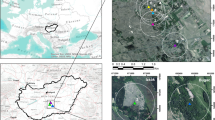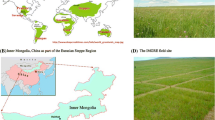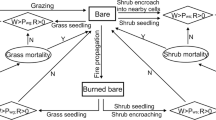Abstract
Grassland ecosystems evolved with natural disturbance events on multiple spatial scales in which focal, fine-scale soil disturbance by animals often was imbedded within large-scale grazing disturbance. The resulting plant communities adapted to both broad-scale and fine-scale disturbance that resulted in species-rich plant communities. These natural disturbance regimes have been largely replaced by anthropogenic disturbance. While we generally understand grassland response to modern grazing practices, we know much less about plant community response to soil disturbance imbedded within non-focal grazing. Therefore, we used a tracked vehicle to focally disturb soil in a North American mesic mixed prairie that was either undisturbed prairie or prairie with a recent history of disturbance from either grazing or haying. Successional trajectory and recovery time following focal soil disturbance was similar between grazed and hayed plant communities. Species composition did not differ (P < 0.05) between grazed or hayed prairie and the respective undisturbed prairie. Plant species richness and bare ground increased (P < 0.05) following focal soil disturbance in both grazed and hayed communities, but focal soil disturbance combined with either grazing or haying did not change either plant species richness or bare ground more than (P > 0.05) focal soil disturbance alone. Also, the effect of focal soil disturbance was shortlived with recovery in two growing seasons. Our results suggest that anthropogenic focal soil disturbance is a reasonable mechanism to restore soil disturbance to the grassland ecosystem.




Similar content being viewed by others
References
Adler PB, Raff DA, Lauenroth WK (2001) The effect of grazing on the spatial heterogeneity of vegetation. Oecologia 128:465–479
Alba-Lynn C, Detling JK (2008) Interactive disturbance effects of two disparate ecosystem engineers in North American shortgrass steppe. Oecologia 157:269–278
Alkon PU (1999) Microhabitat to landscape impacts: crested porcupine digs in the Negev Desert highlands. J Arid Environ 41:183–202
Althoff PS, Thien SJ (2005) Impact of M1A1 main battle tank disturbance on soil quality, invertebrates, and vegetation characteristics. J Terramechanics 42:159–176
Anderson AB, Palazzo AJ, Ayers PD, Fehmi JS, Shoop S, Sullivan P (2005) Assessing the impacts of military vehicle traffic on natural areas Introduction to the special issue and review of the relevant military vehicle impact literature. J Terramechanics 42:143–158
Anderson AB, Howard H, Ayers P, Butler C, Wu C, Woodford P, Otto C (2006) Soil property influence on military vehicle impacts. American Society of Agricultural and Biological Engineers, Portland, Oregon, USA: paper number 061183
Augustine DJ, McNaughton SJ (1998) Ungulate effects on the functional species composition of plant communities: Herbivore selectivity and plant tolerance. J Wildlife Manage 62:1165–1183
Axelrod DI (1985) Rise of the grassland biome, central North America. Bot Rev 51:163–201
Bartolome JW, Fehmi JS, Jackson RD, Allen-Diaz B (2004) Response of a native perennial grass stand to disturbance in California’s coast range grassland. Restor Ecol 12:279–289
Biondini ME, Manske L (1996) Grazing frequency and ecosystem processes in a northern mixed prairie, USA. Ecol Appl 6:239–256
Biondini ME, Patton BD, Nyren PE (1998) Grazing intensity and ecosystem processes in a northern mixed-grass prairie, USA. Ecol Appl 8:469–479
Braunack MV, Williams BG (1993) The effect of initial soil water content and vegetation cover on surface soil disturbance by tracked vehicles. J Terramechanics 30:299–311
Briske DD, Fuhlendorf SD, Smeins FE (2006) A unified framework for assessment and application of ecological thresholds. Range Ecol Manag 3:225–236
Bullock JM, Pywell RF, Burke JMW, Walker KJ (2001) Restoration of biodiversity enhances agricultural production. Ecol Lett 4:185–189
Collins SL (1987) Interaction of disturbances in tallgrass prairie: a field experiment. Ecology 68:1243–1250
Collins SL, Uno GE (1983) The effect of early spring burning on vegetation in buffalo wallows. Bull Torrey Bot Club 110:474–481
Coppedge BR, Shaw JH (2000) American bison Bison bison wallowing behavior and wallow formation on tallgrass prairie. Acta Theriol 45:103–110
Coppock DL, Ellis JE, Detling JK, Dyer MI (1983) Plant-herbivore interactions in a North American mixed-grass prairie. Oecologia 56:10–15
Critchley CNR, Fowbert JA, Wright B (2007) Dynamics of species-rich upland hay meadows over 15 years and their relation with agricultural management practices. Appl Veg Sci 10:307–314
D’Antonio CM (2000) Fire, plant invasions and global changes. In: Mooney HA, Hobbs RJ (eds) Invasive species in a changing world. Island Press, Washington DC, pp 65–94
D’Antonio CM, Dudley TD, Mack M (1999) Disturbance and biological invasions: direct effects and feedbacks. In: Walker LR (ed) Ecosystems of the world 16. Ecosystems of disturbed ground. Elsevier, New York, pp 413–452
Dale V, Druckenbrod DL, Baskaran L, Aldridge M, Berry M, Garten C, Olsen L, Efroymson R, Washington-Allen R (2005) Vehicle impacts on the environment at different spatial scales: observations in west central Georgia. J Terramechanics 42:383–402
Davies KW, Svejcar TJ, Bates JD (2009) Interaction of historical and nonhistorical disturbances maintains native plant communities. Ecol Appl 19:1536–1545
Dean WRJ, Milton SJ (1991) Disturbances in semi-arid shrubland and arid grassland in the Karoo, South Africa: mammal diggings as germination sites. Afr J Ecol 29:11–16
del Moral R (2007) Limits to convergence of vegetation during early primary succession. J Veg Sci 18:479–488
Detling JK (1998) Mammalian herbivores: ecosystem-level effects in two grassland national parks. Wildlife Soc B 26:438–448
Dickson TL, Wilsey BJ, Busby RR, Gebhart DL (2008) Grassland plant composition alters vehicular disturbance effects in Kansas, USA. Environ Manage 41:676–684
Donath TW, Holzel N, Otte A (2003) The impact of site conditions and seed dispersal on restoration success in alluvial meadows. Appl Veg Sci 6:13–22
Donlan J, Greene HW, Berger J, Bock CE, Bock JH, Burney DA, Estes JA, Foreman D, Martin PS, Roemer FW, Smith FA, Soulé ME (2005) Re-wilding North America. Nature 436:913–914
Egler FE (1954) Vegetation science concepts. 1. Initial floristic composition, a factor in old-field vegetation development. Vegetatio 4:412–414
England RE, DeVos A (1969) Influence of animals on pristine conditions on the Canadian grasslands. J Range Manage 22:87–94
Fleischner TL (1994) Ecological costs of livestock grazing in western North America. Conserv Biol 8:629–644
Foster BL, Dickson TL, Murphy CA, Karel I, Smith VH (2004) Propagule pools mediate community assembly and diversity-ecosystem regulation along a grassland productivity gradient. J Ecol 92:435–449
Fuhlendorf SD, Engle DM (2001) Restoring heterogeneity on rangelands: ecosystem management based on evolutionary grazing patterns. Bioscience 51:625–632
Fuhlendorf SD, Engle DM (2004) Application of the fire-grazing interaction to restore a shifting mosaic on tallgrass prairie. J Appl Ecol 41:604–614
Fuhlendorf SD, Harrell WC, Engle DM, Hamilton RG, Davis CA, Leslie DM Jr (2006) Should heterogeneity be the basis for conservation? Grassland bird response to fire and grazing. Ecol Appl 16:1706–1716
Fuhlendorf SD, Engle DM, Kerby J, Hamilton RG (2009) Pyric-herbivory: rewilding landscapes through re-coupling fire and grazing. Conserv Biol 23:588–598
Garcia A (1992) Conserving the species-rich meadows of Europe. Agr Ecosyst Environ 40:219–232
Gutterman Y, Herr N (1981) Influences of porcupine (Hystrix indica) activity on the slopes of the northern Negev mountains—germination and vegetation renewal in different geomorphological types and slope directions. Oecologia 51:332–334
Harrison YA, Shackleton CM (1999) Resilience of South African communal grazing lands after the removal of high grazing pressure. Land Degrad Dev 10:225–239
Hartnett DC, Hickman KR, Fischer-Walter LE (1996) Effects of bison grazing, fire and topography on floristic diversity in tallgrass prairie. J Range Manag 49:413–420
Heitschmidt RK, Haferkamp MR, Karl MG, Hild AL (1999) Drought and grazing: I. Effects on quantity of forage produced. J Range Manag 52:440–446
Hickman KR, Hartnett DC, Cochran RC, Owensby CE (2004) Grazing management effects on plant species diversity in tallgrass prairie. J Range Manag 57:58–65
James AI, Eldridge DJ (2007) Reintroduction of fossorial native mammals and potential impacts on ecosystem processes in an Australian desert landscape. Biol Conserv 138:351–359
Karafiath LL, Nowatzki EA (1978) Soil mechanics for off-road vehicle engineering. Trans Tech Publications, p 575
Kindscher K, Tieszen LL (1998) Floristic and soil organic matter changes after five and thirty-five years of native tallgrass prairie restoration. Restor Ecol 6:181–196
Knapp PA (1996) Cheatgrass (Bromus tectorum L.) dominance in the Great Basin desert history, persistence, and influences to human activities. Global Environ Chang 6:37–52
Knapp AK, Blair JM, Briggs JM, Collins SL, Hartnett DC, Johnson LC, Towne EG (1999) The keystone role of bison in North American tallgrass prairie. Bioscience 49:39–50
Knops JMH, Tilman D (2000) Dynamics of soil nitrogen and carbon accumulation for 61 years after agricultural abandonment. Ecology 81:88–98
Koford CB (1958) Prairie dogs, whitefaces, and blue grama. Wildlife Monogr 3:1–78
Kotanen PM (1996) Revegetation following soil disturbance in a California meadow: the role of propagule supply. Oecologia 108:652–662
Kyle GP, Beard KH, Kulmatiski A (2007) Reduced soil compaction enhances establishment of non-native plant species. Plant Ecol 193:223–232
Larson DL, Anderson PJ, Newton W (2001) Alien plant invasion in mixed-grass prairie: effects of vegetation type and anthropogenic disturbance. Ecol Appl 11:128–141
Laycock WA (1991) Stable states and thresholds of range condition on North American rangelands—a viewpoint. J Range Manag 44:427–433
Li J, Duggin JA, Loneragan WA, Grant CD (2007) Grassland responses to multiple disturbances on the New England Tablelands in NSW, Australia. Plant Ecol 193:39–57
Limb RF, Fuhlendorf SD, Townsend DE (2009) Heterogeneity of thermal extremes: driven by disturbance or inherent in the landscape. Environ Manag 43:100–106
Limb RF, Engle DM, Fuhlendorf SD, Althoff DP, Gipson PS (2010) Altered herbivore distribution associated with focal disturbance. Range Ecol Manag 63:253–257
Long D, Truett J (2006) Ranching and prairie dogs. USDA For Serv Proc RMRS-P 40:87–89
McIntyre S, Lavorel S (1994) How environmental and disturbances factors influence species composition in temperate Australian grasslands. J Veg Sci 5:373–384
Mielke HW (1977) Mound building by pocket gophers (Geomyidae): their impact on soils and vegetation in North America. J Biogeogr 4:171–180
Milchunas DG, Schultz K, Shaw RB (2000) Plant community structure in relation to long-term disturbance by mechanized military maneuvers in a semiarid region. Environ Manag 25:525–539
Noble IR, Slatyer RO (1980) The use of vital attributes to predict successional changes in plant communities subject to recurrent disturbances. Vegetatio 43:5–21
Noymeir I (1995) Interactive effects of fire and gazing on structure and diversity of Mediterranean grasslands. J Veg Sci 6:701–710
Perrins J, Williamson M, Fitter A (1992) Do annual weeds have predictable characters. Acta Oecol 360:1313–1325
Platt WJ (1975) The colonization and formation of equilibrium plant species associations on badger disturbances in a tall-grass prairie. Ecol Monogr 45:285–305
Polley HW, Collins SL (1984) Relationships of vegetation and environment in buffalo wallows. Am Midl Nat 112:178–186
Prosser CW, Sedevec KK, Barker WT (2000) Tracked vehicle effects on vegetation and soil characteristics. J Range Manag 53:660–670
Rietkerk M, van de Koppel J (1997) Alternate stable states and threshold effects in semi-arid grazing systems. Oikos 79:69–76
Roundy BA, Hardegree SP, Chambers JC, Whittaker A (2007) Prediction of cheatgrass field germination potential using wet thermal accumulation. Range Ecol Manage 60:613–623
Silva CM, Detling JK, Whicker AD, Brizuela MA (1991) Vegetational responses of a mixed-grass prairie site following exclusion of prairie dogs and bison. J Range Manag 44:100–105
Soil Conservation Service (SCS) (1992) Soil survey of Saline County. National Cooperative Soil Survey-United States Department of Agriculture, Kansas, 122 pp
Sousa WP (1984) The role of disturbance in natural communities. Annu Rev Ecol Syst 15:353–392
Stampfli A, Zeiter M (1999) Plant species decline due to abandonment of meadows cannot easily be reversed by mowing. A case study from the southern Alps. J Veg Sci 10:151–164
Steel RGD, Torrie JH, Dickey DA (1997) Principles and procedures of statistics: a biometrical approach, 3rd edn. McGraw-Hill, Boston, MA, pp 557–558
Steuter AA, Steinauer EM, Hill GL, Bowers PA, Tieszen LL (1995) Distribution and diet of bison and pocket gophers in a sandhills prairie. Ecol Appl 5:756–766
Suding KN, Goldberg D (2001) Do disturbances alter competitive hierarchies? Mechanisms of change following gap creation. Ecology 82:2133–2149
Suding KN, Gross KL, Houseman GR (2004) Alternative states and positive feedbacks in restoration ecology. Trends Ecol Evol 19:46–53
Thompson K, Hodgson JG, Rich TCG (1995) Native and alien invasive plants: More of the same? Ecography 18:390–402
Towne EG, Hartnett DC, Cochran RC (2005) Vegetation trends in tallgrass prairie from bison and cattle grazing. Ecol Appl 15:1550–1559
Trager MD, Wilson GWT, Hartnett DC (2004) Concurrent effects of fire regime, grazing and bison wallowing on tallgrass prairie vegetation. Am Midl Nat 152:237–247
USDA, NRCS (2010) The plants database (http://plants.usda.gov, 12 Jan 2010). National Plant Data Center, Baton Rouge, LA 70874-4490, USA
Vallentine JF (2001) Grazing management, 2nd edn. Academic Press, San Diego, CA, 659 pp
Vavra M, Laycock WA, Pieper RD (1994) Ecological implications of livestock herbivory in the west. Society for Range Mangement, Denver, CO, 297 pp
Vermeire LT, Wester DB, Mitchell RB, Fuhlendorf SD (2005) Fire and grazing effects on wind erosion, soil water content, and soil temperature. J Environ Qual 34:1559–1565
Webb RH (1983) Compaction of desert soils by off-road vehicles. In: Webb RH, Wildhire HG (eds) Environmental effects of off-road vehicles: impacts and management in arid regions. Springer, New York, 534 pp
Wheeting LC (1936) Static friction measurements in the study of soil moisture relationships. Soil Sci 41:1–12
Whicker AD, Detling JK (1988) Ecological consequences of prairie dog disturbances. Bioscience 38:778–785
Whitford WG, Kay FR (1999) Biopedturbation by mammals in deserts: a review. J Arid Environ 41:203–230
Williamson M, Fitter A (1996) The varying success of invaders. Ecology 77:1661–1666
Winter SL, Cully JF, Pontius JS (2002) Vegetation of prairie dog colonies and non-colonized shortgrass prairie. J Range Manag 55:502–508
Acknowledgements
This research was funded by the Oklahoma Agricultural Experiment Station and the United States Army Engineer Research and Development Center-Construction Engineering Research Laboratory grant number W9132T-07-P-0095. We thank US Air National Guard, Galen Wiens and numerous technicians for assistance with various aspects of the study.
Author information
Authors and Affiliations
Corresponding author
Rights and permissions
About this article
Cite this article
Limb, R.F., Engle, D.M., Bidwell, T.G. et al. Restoring biopedturbation in grasslands with anthropogenic focal disturbance. Plant Ecol 210, 331–342 (2010). https://doi.org/10.1007/s11258-010-9760-7
Received:
Accepted:
Published:
Issue Date:
DOI: https://doi.org/10.1007/s11258-010-9760-7




